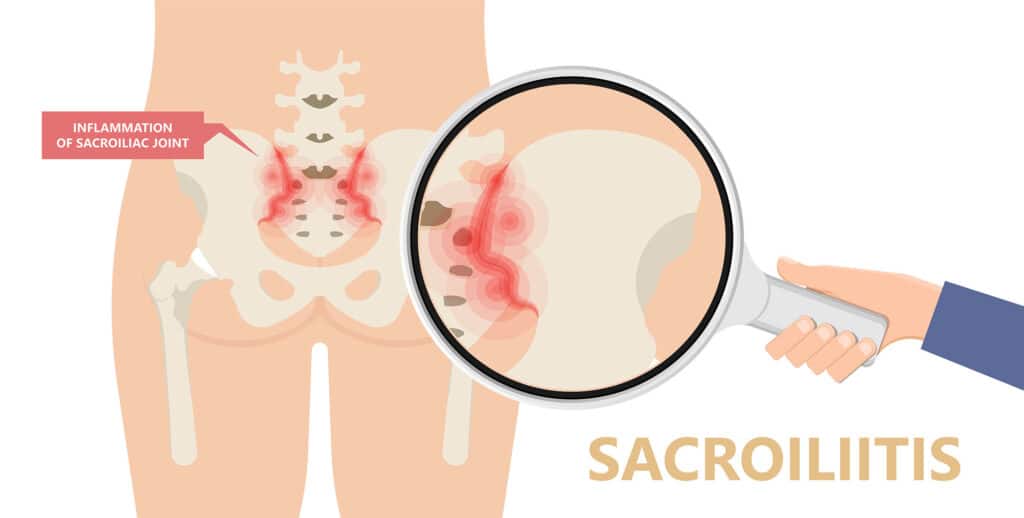Do you have lower back pain, but you aren’t sure why? Does this pain also go through your buttocks? Does it make it difficult to walk, sit, or do other activities? If so, you might have sacroiliitis.
Sacroiliitis can be quite painful, especially when it goes undiagnosed and untreated. Below, learn more about what this condition is, the signs and symptoms, and how to best get support for the side effects that come with sacroiliitis.
What Is Sacroiliitis?

Sacroiliitis specifically impacts the sacroiliac (SI) joints in the body. These are located near your bottom and serve to connect the lower portion of the spine to the pelvis. When somebody has sacroiliitis, it means that there is inflammation of the SI joint.
There are a number of reasons as to why somebody might have an inflamed SI joint. The most simple explanation is that this can happen to anyone as a result of normal wear and tear.
The SI joint is supposed to move smoothly whenever you take a step, bend at the hips, twist to the side, and more. Of course, the more strain that’s put on these joints, the greater the likelihood of them becoming irritated or damaged. So, people with certain jobs or hobbies that involve these repetitive movements are more at risk of developing sacroiliitis.
On the other hand, sacroiliitis can also happen because of underlying medical conditions—particularly ones that affect the joints. Different types of arthritis, for example, can lead to sacroiliitis.
Most commonly, many people who have ankylosing spondylitis will also have sacroiliitis. This condition is an inflammatory arthritis that impacts the joints in the spine. With the spine connecting to and directly interacting with the SI joints, it makes sense that this area would be affected by swelling. In fact, SI joint pain is one of the earliest symptoms of ankylosing spondylitis.
Studies show that sacroiliac joint dysfunction shows up in the majority of people who have psoriatic arthritis as well. Since arthritis is a disorder that causes inflammation throughout the body, the chance of this swelling happening at the SI joint with any type of arthritis is high.
Sometimes, it can be challenging to get a diagnosis of sacroiliitis because of the symptoms. The symptoms often mirror other disorders. A good percentage of people don’t end up getting diagnosed with this disorder, despite having all of the signs. But this is why it’s important to report any pain, swelling, or other symptoms you have to a medical professional. Let’s now learn about the symptoms of sacroiliitis so that you know what to look out for.
What Are the Signs and Symptoms of Sacroiliitis?
First and foremost, the number one symptom of sacroiliitis is pain. Specifically, pain in the lower back or base of the spine where it connects to the pelvis. It’s important to note, though, that this isn’t the only place the pain can occur.
Because the sacroiliac joint is one of the largest in the body, when it is inflamed, it can cause a ripple effect throughout the surrounding muscles and ligaments. The pain doesn’t always stay centralized to the inflamed area. Rather, it can spread upward and downward.
What this results in for many people is severe lower back pain as well as pain that goes through the buttocks and sometimes shoots into the legs. Other symptoms could include:
- Pain when sitting
- Difficulty walking
- Limited range of motion in hips
- Elevated temperature
- Stiff joints
As you can imagine, the pain that this condition causes can become quite debilitating. It can make it challenging to work, socialize, run errands, etc. Having a variety of treatment options for sacroiliitis is essential to reduce the pain so that it doesn’t completely take over.
How Do You Treat Sacroiliitis?

The first step in treating sacroiliitis is to seek out professional medical advice. To be diagnosed with sacroiliitis, a trusted medical professional will listen to your symptoms and may also perform a physical exam to assess you. This physical exam could be used to point out the most painful areas as well as test your range of motion. By gathering all of this information, your doctor will be better equipped to give a diagnosis of sacroiliitis.
With a diagnosis in hand, you can start approaching the pain with different treatment options. These include:
- Medication—For some people with sacroiliitis, over the counter medications pain that are meant to reduce inflammation and discomfort can do the trick. Of course, this isn’t true for everyone. Instead, some anti-inflammatory medications might be necessary to take down the swelling in the SI joints. When these are still not enough to touch the pain, some people could benefit from muscle relaxers or even opioid pain medications. However, know that these options come with risks. As always, be sure to get professional medical advice before starting or stopping any medication.
- Physical therapy—Working with a physical therapist can help to reduce pain over time as you build strength in your core, back, and hips. All of these areas need to be strong and in proper alignment to prevent more inflammation of the SI joints. Plus, a physical therapist can work to increase your range of motion, which, in time, can alleviate some pain.
- Alternative pain management—Sometimes, people with sacroiliitis have to get creative with pain management techniques. Combining the right medications with physical therapy is a start, but alternative approaches are sometimes needed. Some examples of this could be going on an anti-inflammatory diet. New pain relief techniques, like sound wave therapy, have been proven to be successful as well for other types of chronic pain. Many times, people who are struggling with sacroiliac pain are willing to try anything just to get some relief. Whether that’s an alternative pain management approach, doing cognitive behavioral therapy, or just having the right people to talk to, there are many options out there for sacroiliitis pain relief.
Looking For More Support?
What often goes overlooked with sacroiliitis is the emotional and mental exhaustion that this type of chronic pain can bring. You might find yourself feeling frustrated at the pain. You might even notice symptoms of depression because of the pain.
There’s a whole group of people who understand what it’s like to live with pain. Get additional support while you’re on your chronic pain journey by joining the Pain Resource Community. Know that you’re not alone in this, and living with less pain is possible with the right support.
What are your thoughts on this article?
Let us know in the comments below!
What topics should we cover next?
Email us your ideas at info@painresource.com!
Did you know we have different groups for different conditions?


I do sometimes
This sounds like what I might have